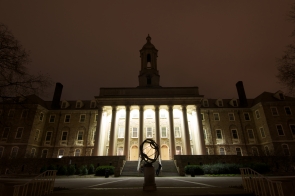
UNIVERSITY PARK — The exterior lights on Penn State’s Old Main will go out for Earth Hour 2013 at 8:30 p.m. Saturday. Penn State is participating in the global call to action by turning off decorative lighting at key campus landmarks.
“We feel it is symbolically important to join in this worldwide effort to show the effect that many people, working together, can have on climate change,” says Steve Maruszewski, assistant vice president of Penn State’s Office of Physical Plant.
In addition, decorative floodlights at the Lion Shrine, the Nittany Lion Inn and the Information Sciences and Technology Building will be turned off.
Penn State’s Liberal Arts Undergraduate Council (LAUC) is sponsoring this year’s event on the Old Main patio. Junior Sarina Katz, an international relations and history major, is organizing the event for the second consecutive year. She said it will include sparklers, trivia, prizes and other activities. Penn State’s RAM Squad, NOMMO, Blue Band Trumpets and the Ballroom Dance Club will perform.
As the Old Main lights are turned off, candles, lanterns and even human tic-tac-toe will light up the night in honor of the event. A community-wide event, businesses and local residents also are encouraged to attend the event and leave their lights off at home. In addition to the festivities on the Old Main patio, the public is invited to join the Department of Astronomy and Astrophysics for a night of free stargazing on the roof of Davey Lab starting at 8:30 p.m., weather permitting.
The goal of Earth Hour is to bring awareness to climate change and environmental conservation by turning off lights. Astronomers have watched light pollution increase for decades and are joining Earth Hour to bring attention to this international problem. Some urban children have never seen the Milky Way or ever seen the stars. Unnecessary lighting inhibits astronomy, but it also wastes energy, disturbs animals and ecosystems and has health implications.
To learn more about light pollution, visit International Dark-Sky Association.
Penn State join more than a billion people in this event sponsored by the World Wide Fund for Nature (WWF). Other cultural icons that will go dark include Chicago’s Sears Tower, the Golden Gate Bridge in San Francisco, the United Nations and Empire State Building in New York and the Eiffel Tower in Paris. What began as an effort in Sydney, Australia six years ago has grown into a worldwide celebration of people power to turn off unnecessary lighting. Everyone is encouraged to participate by turning off unnecessary lighting.
For more information about Penn State’s sustainability initiatives, visit http://sustainability.psu.edu/. To learn how you and your organization can participate, visit http://www.earthhour.org/


